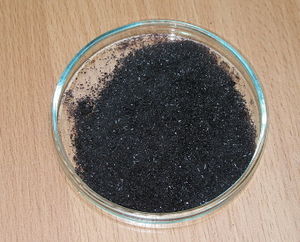Difference between revisions of "Potassium peroxochromate"
(Created page with "{{Chembox | Name = Potassium peroxochromate | Reference = | IUPACName = Potassium tetraperoxochromate(V) | PIN = | SystematicName = | OtherNames = Potassium tetraperoxochromat...") |
|||
| (4 intermediate revisions by the same user not shown) | |||
| Line 7: | Line 7: | ||
| OtherNames = Potassium tetraperoxochromate | | OtherNames = Potassium tetraperoxochromate | ||
<!-- Images --> | <!-- Images --> | ||
| − | | ImageFile = | + | | ImageFile = Potassium peroxochromate K3CrO8 by woelen.jpg |
| − | | ImageSize = | + | | ImageSize = 300 |
| ImageAlt = | | ImageAlt = | ||
| ImageName = | | ImageName = | ||
| + | | ImageCaption = Sample of K<sub>3</sub>CrO<sub>8</sub>. | ||
| ImageFile1 = | | ImageFile1 = | ||
| ImageSize1 = | | ImageSize1 = | ||
| Line 56: | Line 57: | ||
| HenryConstant = | | HenryConstant = | ||
| LogP = | | LogP = | ||
| − | | MolarMass = | + | | MolarMass = 297.286 g/mol |
| MeltingPt = | | MeltingPt = | ||
| MeltingPtC = | | MeltingPtC = | ||
| Line 89: | Line 90: | ||
| AutoignitionPt = | | AutoignitionPt = | ||
| ExploLimits = | | ExploLimits = | ||
| − | | ExternalMSDS = | + | | ExternalMSDS = None |
| FlashPt = | | FlashPt = | ||
| LD50 = | | LD50 = | ||
| Line 116: | Line 117: | ||
===Physical=== | ===Physical=== | ||
| − | Potassium peroxochromate is a dark brown solid, sparingly soluble in water, somewhat similar in appearance | + | Potassium peroxochromate is a dark brown solid, sparingly soluble in water, somewhat similar in appearance to [[potassium ferrate]]. |
===Explosive=== | ===Explosive=== | ||
| Line 127: | Line 128: | ||
==Preparation== | ==Preparation== | ||
| − | Two beakers, one containing 15 | + | Two beakers, one containing 15-30% aqueous [[hydrogen peroxide]] and [[potassium chromate]] solution are kept in a freezer and chilled at low temperatures. The hydrogen peroxide is added slowly to the K<sub>2</sub>CrO<sub>4</sub>. This causes the solution to change color from yellow in red-brown, and finally dark brown. Leave the solution in the freezer until all the bubbling has stopped. Cool the solution below 0 ºC and wait for the crystals to precipitate. Carefully decant the liquid above the crystals, then rinse the crystals two times with cold distilled water, 7 ml each. After the water rinse, the wet crystals are rinsed with 2x7 ml [[ethanol]]. Another rinsing with [[diethyl ether]] is optional. The rinsed crystals are added on a filter paper which will absorb the leftover ethanol. The crystals are then transferred on a watchglass or Petri dish and left to dry in open air.<ref>http://woelen.homescience.net/science/chem/exps/K3CrO8_synth/index.html</ref> |
==Projects== | ==Projects== | ||
Latest revision as of 22:44, 27 June 2017
 Sample of K3CrO8.
| |
| Names | |
|---|---|
| IUPAC name
Potassium tetraperoxochromate(V)
| |
| Other names
Potassium tetraperoxochromate
| |
| Properties | |
| K3CrO8 K3[Cr(O2)4] | |
| Molar mass | 297.286 g/mol |
| Appearance | Dark brown crystalline solid |
| Melting point | Decomposes |
| Boiling point | Decomposes |
| Poorly soluble | |
| Solubility | Insoluble in ethanol, diethyl ether |
| Hazards | |
| Safety data sheet | None |
| Related compounds | |
| Related compounds
|
Potassium chromate |
| Except where otherwise noted, data are given for materials in their standard state (at 25 °C [77 °F], 100 kPa). | |
| Infobox references | |
Potassium peroxochromate, or potassium tetraperoxochromate(V), is an inorganic compound chemical having the chemical formula K3[Cr(O2)4] or K3CrO8.
Contents
Properties
Chemical
Potassium peroxochromate is a rare example of a Cr in the +5 oxidation state.
The addition of an acid will give chromium(VI) oxide peroxide
Physical
Potassium peroxochromate is a dark brown solid, sparingly soluble in water, somewhat similar in appearance to potassium ferrate.
Explosive
Potassium tetraperoxochromate will burn when ignited and may explode. It is sensitive to shock and friction.
Mixtures with aluminium, sulfur or red phosphorus are very sensitive to shock and detonate when struck. Quantities as small as 10 mg can explode with a loud crack.
Availability
Potassium tetraperoxochromate does not appear to be sold by any chemical entity.
Preparation
Two beakers, one containing 15-30% aqueous hydrogen peroxide and potassium chromate solution are kept in a freezer and chilled at low temperatures. The hydrogen peroxide is added slowly to the K2CrO4. This causes the solution to change color from yellow in red-brown, and finally dark brown. Leave the solution in the freezer until all the bubbling has stopped. Cool the solution below 0 ºC and wait for the crystals to precipitate. Carefully decant the liquid above the crystals, then rinse the crystals two times with cold distilled water, 7 ml each. After the water rinse, the wet crystals are rinsed with 2x7 ml ethanol. Another rinsing with diethyl ether is optional. The rinsed crystals are added on a filter paper which will absorb the leftover ethanol. The crystals are then transferred on a watchglass or Petri dish and left to dry in open air.[1]
Projects
- Make CrO5
Handling
Safety
Potassium peroxochromate is a strong irritant and is corrosive. It will bleach skin on contact and cause a stinging sensation, similar to hydrogen peroxide. It is also sensitive to strong shock and may explode.
Storage
Can be stored in closed glass containers and kept in dry and clean places for many years, as noted by several SM members.
Disposal
A reducing agent, such as sulfite can be used.
Acidifying an aqueous solution of K3CrO8 will cause it to convert to CrO5 which rapidly decomposes in water to release oxygen.